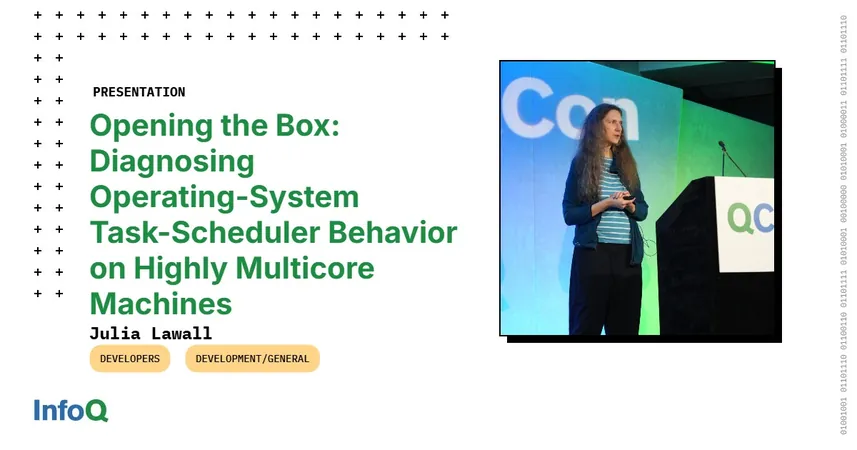
Unpacking Performance: How Operating System Schedulers Affect Multicore Machines
2025-04-15
Author: Olivia
Unlocking the Mysteries of Task Scheduling
In today’s tech talks, we dive into the complex world of operating system (OS) task schedulers, especially focusing on their impact on highly multicore machines. In essence, the operating system stands as a mediator between user applications and hardware, ensuring resources are allocated efficiently and securely.
The Crucial Role of the Task Scheduler
Task schedulers are at the heart of OS performance. They determine not only which tasks run but also where exactly they run on multicore systems. In this discussion, we shine the spotlight on the Linux task scheduler. When we change OS versions, unexpected performance anomalies can occur, making it imperative to understand how scheduling decisions impact application efficiency.
Diving Deeper: What Schedulers Do
Schedulers decide which tasks run on which cores, but they operate with very limited information about future demands or current workloads. Poor scheduling can cause slowdowns that significantly affect application performance over time.
Key Scheduling Concepts: Work Conservation and Locality
Two significant principles emerge in scheduling strategies: work conservation, which ensures no core is overloaded if others remain idle; and locality, aiming to keep tasks close to the data they need. Striking that balance is where the challenge lies.
The Challenge of Load Balancing
With numerous tasks, load balancing is crucial to maintain performance. Yet, as tasks vie for CPU resources, inefficiencies, such as idle cores, can cause significant slowdowns. This issue appears starkly when visualizing performance through graphical tools.
Profiling Tools: Gaining Insights into Performance Issues
Tools like trace-cmd and KernelShark offer a window into the task scheduler's decisions, helping developers visualize core activity. However, they can be unwieldy on large-scale systems. Thus, innovative visualization methods are critical for improving performance diagnostics.
Research Insights: Case Study Analysis
A focused examination of a Block Tri-diagonal solver application from the NAS benchmark suite reveals challenges and solutions. Running 64 tasks on 64 cores should ideally yield simple scheduling; however, the Linux kernel doesn't always manage this efficiency, especially under specific workloads.
Understanding Gaps: The Role of Idle Cores
In slower runs, noticeable gaps in task execution signal potential performance pitfalls. These gaps often indicate an inability to effectively utilize idle cores, leading to significant performance degradation.
Assessing Scheduler Performance: What Works?
The study illustrates how identifying gaps and analyzing scheduling behavior can illuminate broader systemic issues. By employing tools to isolate the causes of overloads and inefficiencies, developers can work towards better balancing in future OS iterations.
Conclusion: The Journey Ahead for OS Scheduling
Our exploration makes one thing clear: achieving peak performance requires a thorough understanding of task scheduling. While tools exist to assist in visualizing the data, the ultimate goal remains identifying and correcting inefficiencies in scheduling logic. With ongoing research, we strive to refine OS performance across multicore environments.
Join the Discussion
As we continue to delve into the intricacies of OS scheduling, your thoughts and experiences are invaluable. How have you tackled performance issues in your own multicore applications? What tools have proven most effective for your diagnostics?









 Brasil (PT)
Brasil (PT)
 Canada (EN)
Canada (EN)
 Chile (ES)
Chile (ES)
 Česko (CS)
Česko (CS)
 대한민국 (KO)
대한민국 (KO)
 España (ES)
España (ES)
 France (FR)
France (FR)
 Hong Kong (EN)
Hong Kong (EN)
 Italia (IT)
Italia (IT)
 日本 (JA)
日本 (JA)
 Magyarország (HU)
Magyarország (HU)
 Norge (NO)
Norge (NO)
 Polska (PL)
Polska (PL)
 Schweiz (DE)
Schweiz (DE)
 Singapore (EN)
Singapore (EN)
 Sverige (SV)
Sverige (SV)
 Suomi (FI)
Suomi (FI)
 Türkiye (TR)
Türkiye (TR)
 الإمارات العربية المتحدة (AR)
الإمارات العربية المتحدة (AR)